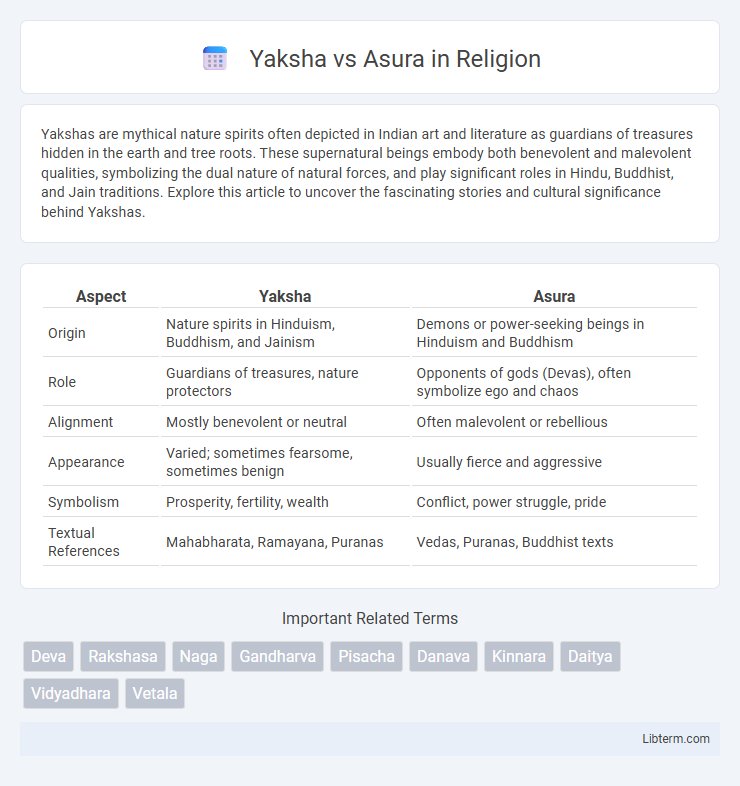Yakshas are mythical nature spirits often depicted in Indian art and literature as guardians of treasures hidden in the earth and tree roots. These supernatural beings embody both benevolent and malevolent qualities, symbolizing the dual nature of natural forces, and play significant roles in Hindu, Buddhist, and Jain traditions. Explore this article to uncover the fascinating stories and cultural significance behind Yakshas.
Table of Comparison
| Aspect | Yaksha | Asura |
|---|---|---|
| Origin | Nature spirits in Hinduism, Buddhism, and Jainism | Demons or power-seeking beings in Hinduism and Buddhism |
| Role | Guardians of treasures, nature protectors | Opponents of gods (Devas), often symbolize ego and chaos |
| Alignment | Mostly benevolent or neutral | Often malevolent or rebellious |
| Appearance | Varied; sometimes fearsome, sometimes benign | Usually fierce and aggressive |
| Symbolism | Prosperity, fertility, wealth | Conflict, power struggle, pride |
| Textual References | Mahabharata, Ramayana, Puranas | Vedas, Puranas, Buddhist texts |
Introduction to Yaksha and Asura
Yakshas are nature-spirits in Hindu, Buddhist, and Jain mythology, often depicted as benevolent guardians of treasures hidden in the earth and tree roots. Asuras are powerful supernatural beings in Indian religions, frequently portrayed as antagonistic forces opposing the gods (Devas) and embodying chaos and pride. Both Yakshas and Asuras have complex roles and characteristics, functioning as symbolic representations of various natural and cosmic forces.
Origins in Hindu Mythology
Yakshas and Asuras in Hindu mythology originate from distinct cosmic lineages influencing their roles and characteristics. Yakshas are considered nature spirits associated with treasures hidden in the earth and linked to Kubera, the god of wealth, symbolizing benevolence and guardianship. Asuras descend from Kashyapa's lineage, often portrayed as powerful beings opposing the Devas, embodying chaos and ambition in mythological narratives.
Physical Characteristics Compared
Yakshas are typically depicted as sturdy, benevolent nature spirits with broad shoulders, round faces, and often adorned with simple jewelry, symbolizing their connection to natural elements. Asuras possess more fierce and intimidating physical traits, such as muscular builds, pronounced fangs, glowing eyes, and elaborate armor, reflecting their aggressive and combative nature. Both beings exhibit supernatural features, but Yakshas tend to appear calm and robust, whereas Asuras are marked by their dynamic, warlike appearance.
Roles in Ancient Texts
Yakshas are depicted in ancient Indian texts as nature spirits and guardians of treasures hidden in the earth, often portrayed as benevolent protectors associated with fertility and wealth. Asuras are primarily characterized as powerful beings often in opposition to the gods (Devas), embodying chaos and ambition, frequently engaging in battles for cosmic control in scriptures like the Mahabharata and Puranas. The contrasting roles highlight Yakshas as custodians of natural elements and Asuras as antagonists challenging divine order.
Symbolic Meanings and Allegories
Yakshas symbolize nature spirits embodying wealth, fertility, and protection, often depicted as guardians of treasures and natural resources in Hindu and Buddhist traditions. Asuras represent powerful but often malevolent forces embodying chaos, ambition, and the struggle between good and evil, frequently portrayed as antagonists in mythological narratives. The allegory of Yaksha versus Asura illustrates the eternal conflict between harmony and disorder, light and darkness, or spiritual balance versus material greed.
Yaksha vs Asura in Folklore
Yakshas and Asuras represent contrasting supernatural beings in Hindu and Buddhist folklore, with Yakshas often depicted as nature spirits or guardians of wealth, while Asuras are portrayed as powerful demons or anti-gods frequently engaged in cosmic battles against devas. Folklore highlights Yakshas as protectors of treasures and forests, embodying benevolent or neutral traits, whereas Asuras symbolize chaos and opposition to divine order, often embodying ambition and moral ambiguity. This dichotomy reinforces themes of good versus evil and order versus chaos prevalent in ancient Indian mythological narratives.
Powers and Abilities
Yakshas possess supernatural strength, control over nature, and the ability to grant wealth and protection, often depicted as guardians of treasures in Hindu and Buddhist mythology. Asuras are powerful demonic beings with immense magical abilities, mastery over illusions, and aggressive combat skills, frequently challenging the gods in epic battles. The conflict between Yakshas and Asuras symbolizes the struggle between benevolent guardianship and chaotic power, highlighting contrasting supernatural capabilities in ancient Indian lore.
Relationships with Gods and Humans
Yakshas are often depicted as benevolent nature spirits allied with gods, serving as guardians of treasures and protectors of humans in Hindu, Buddhist, and Jain traditions. Asuras, in contrast, are portrayed as powerful beings frequently in opposition to gods, embodying chaos and ambition, and often challenging divine authority. While Yakshas foster harmony between the divine and human realms, Asuras symbolize conflict and struggle within mythological narratives.
Modern Interpretations
Modern interpretations of Yaksha and Asura highlight their symbolic roles in psychology and popular culture, with Yakshas often seen as guardians of hidden wealth or subconscious forces and Asuras representing inner demons or chaotic energies. Contemporary media, including films and video games, reimagine these mythological beings as complex characters embodying moral ambiguity rather than purely good or evil entities. Academic discourse explores these figures as metaphors for the human struggle between order and chaos, reflecting evolving societal values and spiritual understandings.
Conclusion: Key Differences and Similarities
Yakshas and Asuras both originate from ancient Indian mythology as supernatural beings but differ mainly in their moral alignment and roles; Yakshas are typically benevolent nature spirits associated with wealth and fertility, while Asuras are often depicted as antagonistic deities embodying power and chaos. Both groups share supernatural abilities and frequent interactions with gods and humans, highlighting their importance in mythological narratives. Their contrasting yet overlapping characteristics reflect the duality of order and disorder within Hindu cosmology.
Yaksha Infographic

 libterm.com
libterm.com